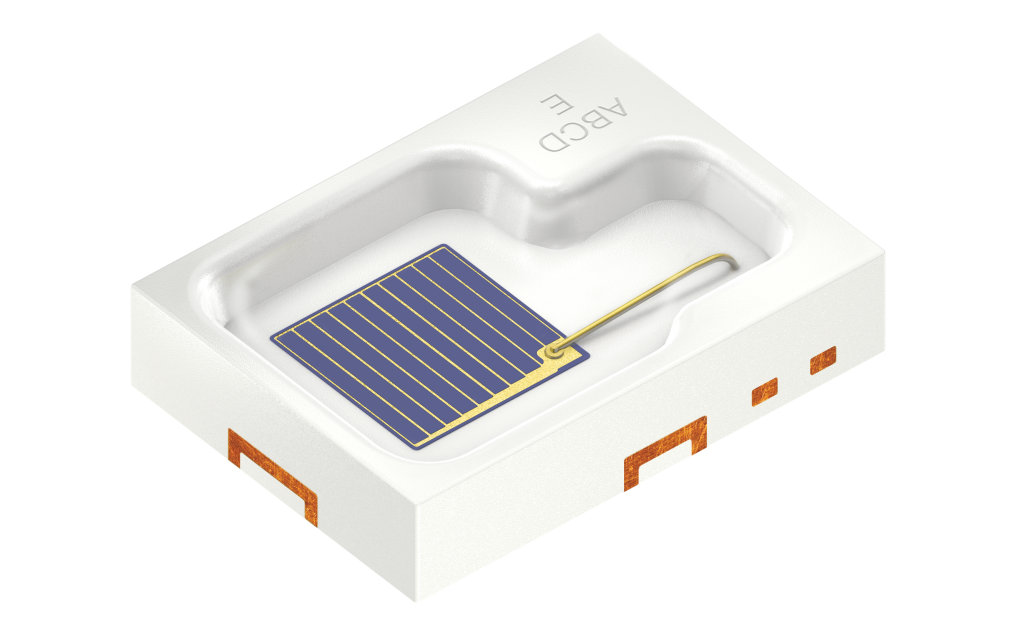A new generation of infrared LEDs for night vision assistance
A new infrared LED from Osram Opto Semiconductors reduces the size of lighting units for camera-based assistance systems in cars. Compared to the Platinum Dragon previously used, Synios SFH 4770S A01 offers 25 percent higher optical output and needs only about one tenth of the footprint.

Osram presented its first Synios infrared LED (IRED) for the consumer market, the SFH 4770S, only last year. Now the component is suitable also for use in vehicles. The main applications for this IRED with a wavelength of 850 nanometers (nm) are infrared lighting units for camera systems that monitor the outside environment of the car. These systems include night vision assistants and forward collision detection systems such as pedestrian protection solutions that work with camera images. Flooding the scene in front of the vehicle with infrared light enables the vehicle environment to be reliably detected even in the dark or in poor weather conditions. Unlike laser-based assistance systems, which work with pulsed light, the above-mentioned systems tend to use permanent light sources.
Outstanding efficiency
Synios SFH 4770S A01 will replace the established Dragon family in these applications. The main requirement is high optical output in continuous operation (DC). The new IRED delivers an optical output of almost 1,200 milliwatts from a current of 1 ampere and is therefore around a quarter brighter than the Platinum Dragon SFH 4235 for example. “SFH 4770S A01 currently offers the best efficiency and the best ratio between component size and optical output on the market for the automotive sector”, said Dr. Walter Rothmund, Head of Marketing Infrared Automotive at Osram Opto Semiconductors. Like its predecessor, the SFH 4770S A01 contains a highly efficient chip in nanostack technology featuring two light-emitting p-n junctions. The typical forward voltage is 3.2 V.
Lower system costs
Like the Dragon LED SFH 4235, the Synios is also a Lambertian radiator which is ideal for reflector-based systems. The Synios package measures 2.75 × 2.0 × 0.6 mm, making it considerably smaller than that of the Dragon; in particular it requires only about one tenth of the footprint. Its thermal conductivity has not changed however, and its thermal resistance is still typically 6 kelvin per watt (K/W). Designers can therefore create much smaller systems with the same thermal management. Thanks to higher optical output fewer components are needed to produce the same brightness levels, which in turn reduces system costs still further.
| Technical data | Synios SFH 4770S A01 |
Platinum Dragon SFH 4235 |
| Wavelength | 850 nm | 850 nm |
| Half angle | ±60° | ±60° |
| Optical output | typ. 1700 mW at 1.5 A; 1140 at 1 A |
typ. 950 mW at 1 A |
| Radiant intensity | typ. 530 mW/sr at 1.5 A; 350 mW/sr at 1A |
typ. 320 mW/sr |
| Forward voltage | typ. 3.35 V at 1.5 A; 3.2 V at 1 A |
typ. 3.0 V |
| Direct current | max. 1.5 A | max. 1 A |
| Dimensions | 2.75 mm × 2.0 mm × 0.6 mm | 6.0 mm × 11 mm × 1.8 mm |
| Thermal resistance | typ. 6 K/W, max. 9 K/W | typ. 6 K/W, max. 9 K/W |
| Operating temperature | –40 to + 125 °C | –40 to + 125 °C |
